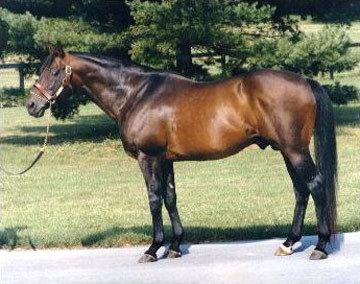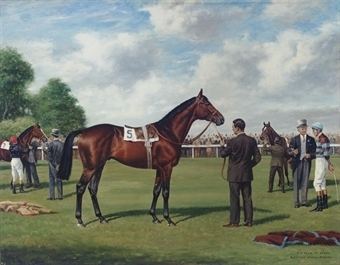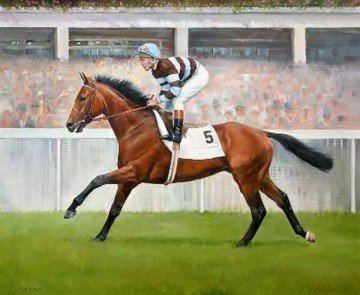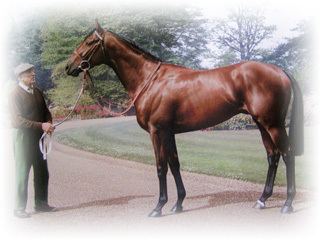Dam Attica Foaled 1965 Died 10 November 1995 Parents Sir Gaylord Sex Stallion | Damsire Mr. Trouble Country United States | |
 | ||
Children Ivanjica, Cloonlara, Sir Tristram, Godetia, French Holly, Bates Motel | ||
Sir ivor 1968 washington dc international
Sir Ivor (May 5, 1965 – November 10, 1995) was an American-bred Irish-trained Thoroughbred racehorse and sire. who competed from a base in Ireland. In a career which lasted from July 1967 to October 1968 he ran thirteen times and won eight races. He won major races in four countries: the National Stakes in Ireland, the Grand Criterium in France, the 2000 Guineas and the Epsom Derby in England and the Washington, D.C. International in the United States. he was retired to stud at the end of the 1968 season and became a successful stallion.
Contents
- Sir ivor 1968 washington dc international
- Sir ivor derby 68
- Background
- 1967 two year old season
- 1968 three year old season
- Stud record
- Assessment and honours
- References

Sir ivor derby 68
Background

Sir Ivor was bred by Alice Headley Bell at the Mill Ridge Farm in Kentucky. He was from the second crop of foals sired by Secretariat's half-brother Sir Gaylord, out of the mare Attica, who produced several other winners. As a yearling the colt was sent to the sales and was bought for $42,000 (equivalent to $310,000 in 2016) by American businessman and U.S. Ambassador to Ireland, Raymond R. Guest, who named the horse after his British grandfather, Sir Ivor Guest, 1st Baron Wimborne. Sir Ivor was sent to Ireland to be trained by Vincent O'Brien at Ballydoyle.
1967: two-year-old season

Sir Ivor's first three races were at Curragh. In July, he finished sixth in the Tyros Stakes and then won the Probationers' Stakes. He was then stepped up in class and won the National Stakes. On his final start of the year, he was sent to Paris to contest the Grand Criterium at Longchamp Racecourse. He established himself as one of the best European colts of his generation with a three-length win.
1968: three-year-old season

On his three-year-old debut, Sir Ivor traveled to England for the first time and won the 2000 Guineas Trial Stakes at Ascot. He then started 11/8 favourite for the 2000 Guineas at Newmarket in which his main rival was expected to be the English colt Petingo. Ridden by Lester Piggott, Sir Ivor accelerated past Petingo in the closing stages to win by one and a half lengths.
At Epsom Sir Ivor was made 4/5 favourite for the Derby. Held up in the early stages by Piggott, he turned into the straight in seventh place. In the closing, he produced what the Glasgow Herald described as an "electrifying surge" of speed on the outside to catch the leader Connaught well inside the final furlong and win by one and a half lengths. After the race, Piggott described Sir Ivor as "the best I have ridden." Sir Ivor had now won six races in succession, but his run of success ended in his next race, as he was beaten two lengths by Ribero in the Irish Derby. He was then matched against 1967 Derby winner Royal Palace in the Eclipse Stakes at Sandown. In a closely contested race, Sir Ivor finished third, beaten a short head and three quarters of a length by Royal Palace and Taj Dewan. He was then rested for an autumn campaign. Although Piggott was criticised for giving the colt too much ground to make up, both he and O'Brien blamed the firm ground for Sir Ivor's defeat.
Sir Ivor returned in late September when he ran in the Prix Henry Delamarre at Longchamp in which he finished half a length second to Prince Sao, to whom he was conceding nine pounds. One week later, he returned to Longchamp for the Prix de l'Arc de Triomphe. He proved no match for the favourite, Vaguely Noble, who won by three lengths, but finished four lengths ahead of the remainder of the field to take second. Two weeks after his run in Paris, Sir Ivor appeared at Newmarket, where he won the Champion Stakes easily by two and a half lengths from a field which included Taj Dewan. On his final start, Sir Ivor was sent to the United States for the Washington, D.C. International at Laurel Park, Maryland. Piggott held the colt up before producing a "furious stretch drive" to lead in the last twenty yards and beat Czar Alexander, with the American Champion Male Turf Horse Fort Marcy in third.
Stud record
Retired after his 3-year-old racing season, Sir Ivor was sold to a syndicate to stand at stud at Claiborne Farm in Paris, Kentucky. He sire 94 stakes winners and was the broodmare sire of more than 145 stakes winners before his death at age 30 in 1995. His best winners included Ivanjica (Prix de l'Arc de Triomphe), Optimistic Gal (Spinster Stakes, Frizette Stakes, Kentucky Oaks), Sweet Alliance (Kentucky Oaks), Godetia (Irish 1000 Guineas, Irish Oaks), and the American Champion Older Male Horse Bates Motel.
Assessment and honours
Sir Ivor was named British Horse of the Year by the Racecourse Association, gaining twenty-six of the forty votes to defeat Royal Palace. He was awarded a rating of 135 by Timeform. In their book A Century of Champions, John Randall and Tony Morris rated Sir Ivor as a “superior” Derby winner and the seventh best Irish racehorse of the 20th Century.
Sir Ivor was the subject of the 1969 documentary film "The Year of Sir Ivor".
A street in the town of Newmarket, Ontario Canada, was named after Sir Ivor. The street is called Sir Ivor Court and is located in the upper-class neighbourhood of Stonehaven in the southeast corner of the town.
